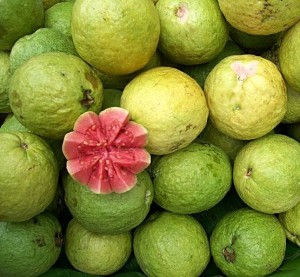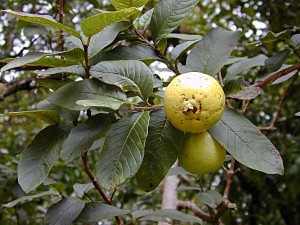 Guava (Psidium guajava L.) or Apple Guava and popularly known as Bayabas in the Philippines, is the sweet fruit which grows in tropical regions of America and Asia. The guava fruit can be eaten raw or used to flavor drinks, desserts, and sauces. The guava is believed to have originated in an area extending from southern Mexico into Central America.
Guava (Psidium guajava L.) or Apple Guava and popularly known as Bayabas in the Philippines, is the sweet fruit which grows in tropical regions of America and Asia. The guava fruit can be eaten raw or used to flavor drinks, desserts, and sauces. The guava is believed to have originated in an area extending from southern Mexico into Central America.
The guava plant is evergreen, in the form of either shallow-rooted shrubs or trees up to 33 feet in height. The guava tree has a smooth copper-colored bark that flakes off to reveal a green layer underneath and has branches that spread at the top of the tree. The flowers are white, with five petals and numerous stamens. Unlike most tropical fruits, the guava can be grown to fruiting size in pots indoors.
Guava fruit, usually 4 to 12 cm long, are round or oval depending on the species. The outer skin may be rough, often with a bitter taste, or soft and sweet. Varying between species, the skin can be any thickness, is usually green before maturity, but becomes yellow, maroon, or green when ripe and contains many small, hard seeds.
The guava is rich in vitamins A, B, and C, as well as beta carotene. Guavas are widely canned and sold for export, as is guava juice, guava nectar, and guava shells, which are stewed and served as a desert in Latin America and Spanish-speaking islands of the West Indies. There are countless recipes for the use of guava in pies, cakes, puddings, jellies, and chutneys, and the guava may even be dehydrated and powdered to flavor ice cream. In the Philippines, we used the guava fruit in some dishes like Sinigang sa Bayabas.
Culturing Tropical Guava
Location
Like other tender subtropicals, guavas need a frost-free location, but are not too fussy otherwise. They prefer full sun.
Soil
The guava will tolerate many soil conditions, but will produce better in rich soils high in organic matter. They also prefer a well-drained soil in the pH range of 5 to 7. The tree will take temporary waterlogging but will not tolerate salty soils.
Irrigation
Guavas have survived dry summers with no water in California, although they do best with regular deep watering. The ground should be allowed to dry to a depth of several inches before watering again. Lack of moisture will delay bloom and cause the fruit to drop.
Pruning
Shaping the tree and removing water shoots and suckers are usually all that is necessary. Guavas can take heavy pruning, however, and can be used as informal hedges or screens. Since the fruit is borne on new growth, pruning does not interfere with next years crop.
Fertilization
Guavas are fast growers and heavy feeders, and benefit from regular applications of fertilizer. Mature trees may require as much as 1/2 pound actual nitrogen per year. Apply fertilizer monthly, just prior to heavy pruning.
Frost Protection
Overhead protection and planting on the warm side of a building or structure will often provide suitable frost protection for guavas in cooler areas. A frame over the plant covered with fabric will provide additional protection during freezes, and electric lights can be included for added warmth. Potted plants can be moved to a more protected site if necessary.

Propagation
Guava seed remain viable for many months. They often germinate in 2 – 3 weeks but may take as long as 8 weeks. Since guavas cannot be depended upon to come true from seed, vegetative propagation is widely practiced. They are not easy to graft, but satisfactory techniques have been worked out for patch-budding by the Forkert Method (probably the most reliable method), side-veneer grafting, approach grafting and marcotting The tree can also be grown from root cuttings. Pieces of any roots except the smallest and the very large, cut into 5 – 10 inch lengths, are placed flat in a prepared bed and covered with 2 – 4 inches of soil, which must be kept moist. They may also be grown by air-layering or from cuttings of half-ripened wood. Pieces 1/4 – 1/2 inch will root with bottom heat and rooting-hormone treatment. Trees grown from cuttings or air-layering have no taproot, however, and are apt to be blown down in the first 2 or 3 years. One of the difficulties with budded and grafted guavas is the production of water sprouts and suckers from the rootstocks.
Pests and Diseases
Foliage diseases, such as anthracnose, can be a problem in humid climates. They can be controlled with regular fungicide applications. Where present, root-rot nematodes will reduce plant vigor. Guava whitefly, guava moth and Caribbean fruit fly can be major problems in southern Florida, but have not been reported in California. Mealy-bugs, scale, common white flies and thrips can be problems in California. In some tropical countries the where fruit flies are a problem, the fruit is covered when small with paper sacks to protect it and assure prime quality fruits for the markets.
Harvest
In warmer regions guavas will ripen all year. There is a distinctive change in the color and aroma of the guava that has ripened. For the best flavor, allow fruit to ripen on the tree. The can also be picked green-mature and allowed to ripen off the tree at room temperature. Placing the fruit in a brown paper bag with a banana or apple will hasten ripening. Mature green fruit can be stored for two to five weeks at temperature between 46° and 50° F and relative humidity of 85 to 95 percent. Fruit that has changed color cannot be stored for any extended periods. It bruises easily and will quickly deteriorate or rot. Commercial juice varieties have rock hard inedible seeds, deep pink flesh and hard yellow rinds. They are not good for eating out of hand but have extremely high vitamin C content.
Commercial Potential
Guavas are the only commercially significant myrtaceous fruit. It is an important fruit in many parts of the world suitable for its production. Guava is one of the leading fruits of Mexico.
Photo: Wikipedia